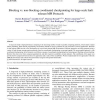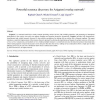FGCS
2008
13 years 11 months ago
2008
The development of many complex simulation applications requires collaborative effort from researchers with different domain knowledge and expertise, possibly at different locatio...
FGCS
2008
13 years 11 months ago
2008
The advent of Grid environments made feasible the solution of computational intensive problems in a reliable and cost-effective way. As workflow systems carry out more complex and...
FGCS
2008
13 years 11 months ago
2008
The purpose of ubiquitous computing is anywhere and anytime access to information within computing infrastructures that is blended into a background and no longer be reminded. Thi...
FGCS
2008
13 years 11 months ago
2008
While large grids are currently supporting the work of thousands of scientists, very little is known about their actual use. Due to strict organizational permissions, there are fe...
FGCS
2008
13 years 11 months ago
2008
As the adoption of grid computing in organizations expands, the need for wise utilization of different types of resources also increases. A volatile resource, such as a desktop co...
FGCS
2008
13 years 11 months ago
2008
Data is typically replicated in a Data Grid to improve the job response time and data availability. Strategies for data replication in a Data Grid have previously been proposed, b...
FGCS
2008
13 years 11 months ago
2008
A long-term trend in high-performance computing is the increasing number of nodes in parallel computing platforms, which entails a higher failure probability. Fault tolerant progr...
FGCS
2008
13 years 11 months ago
2008
Arigatoni is a structured multi-layer overlay network providing various services with variable guarantees, and promoting an intermittent participation in the overlay since peers c...
FGCS
2008
13 years 11 months ago
2008
This paper proposes a bio-inspired approach tailored to the construction of a Grid information system in which content, specifically metadata descriptors that specify the characte...
FGCS
2008
13 years 11 months ago
2008
This paper presents a grid-enabled system for solving large-scale mixed integer programming (MIP) problems. The system has been developed using Globus and MPICH-G2, and consists o...





